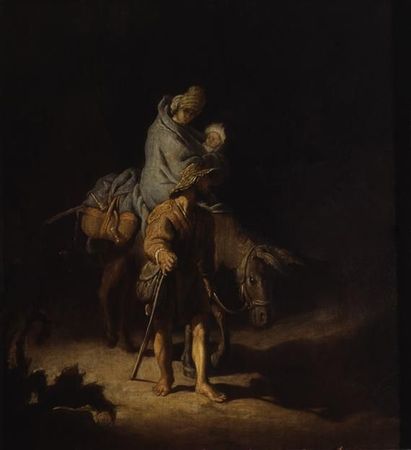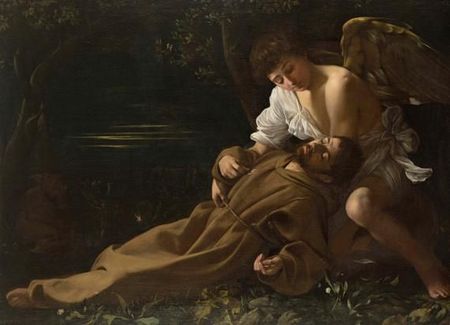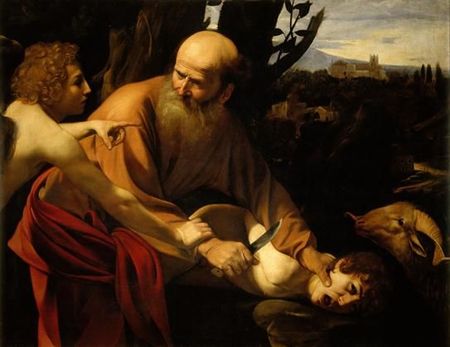"Corps et ombres. Caravage et le caravagisme européen" @ Musée Fabre & Musée des Augustins
"Jeune garçon mordu par un lézard", Michelangelo Merisi dit Le Caravage. Vers 1594, Fondazione di Studi di Storia dell’Arte Roberto Longhi, Florence. (FONDAZIONE ROBERTO LONGHI)
MONTPELLIER.- Membres de l’organisme de coopération franco-américaine FRAME (French Regional American Museum Exchange), le musée Fabre de Montpellier Agglomération et le musée des Augustins de Toulouse s’associent pour proposer une exposition-événement consacrée au caravagisme européen, en collaboration avec le Los Angeles County Museum of Art et le Wadsworth Atheneum Museum of Art de Hartford.
A la fois proches géographiquement et complémentaires par leurs collections, les deux grandes villes du Languedoc avaient toute légitimité à accueillir cette exposition. Alors que le musée des Augustins de Toulouse possède de merveilleux exemples du caravagisme nordique, le musée Fabre de Montpellier Agglomération conserve de très belles oeuvres de ses représentants italiens, espagnols et français du XVIIème siècle. Ces orientations ont déterminé une répartition naturelle constituant les deux volets d’une même exposition.
Rassemblant près de 140 chefs-d’oeuvre des plus grands peintres du XVIIème siècle grâce à la coopération de prestigieuses institutions internationales, l’exposition Corps et Ombres, Caravage et le caravagisme européen témoigne de l’influence révolutionnaire du maître italien sur un demisiècle de peinture.
À Montpellier, Caravage et les caravagesques du Sud.
Au musée Fabre de Montpellier Agglomération, le caravagisme du sud est mis à l’honneur dans un parcours rassemblant près de 75 oeuvres des plus grands maîtres. La salle introductive exceptionnelle expose les chefs-d’oeuvre du Caravage dont plusieurs rarement vus en France. Si les oeuvres de aglione, Saraceni, Orazio ou Artemisia Gentileschi témoignent de l’immédiate influence du maître, une section est plus particulièrement consacrée à la peinture à Rome entre 1610 et 1630, ville depuis laquelle Manfredi et les peintres français (Vouet, Valentin, Vignon) contribuent à populariser les procédés chers au Caravage. La section suivante est spécialement dédiée à des peintres non retenus comme spécifiquement caravagesques mais ayant été tentés, à un moment de leur carrière, par le caravagisme (Reni, Spada, Guercino, Strozzi ou Cairo). L’empreinte du style caravagesque à Naples, puis en Espagne, est illustrée par des représentants de premier ordre : Caracciolo, Velásquez, Zurbarán et Ribera. Enfin, l’exposition s’achève magistralement avec l’un des plus illustres « peintres de la réalité » dont l’oeuvre évoque naturellement celle de Caravage : le français Georges de La Tour.
"Le Nouveau-né", Georges de la Tour (1593-1652). Vers 1645, huile sur toile, 0,76 x 0,92 m, musée des Beaux-Arts de Rennes. (MUSÉE DES BEAUX-ARTS DE RENNES / LOUIS DESCHAMPS)
À Toulouse, le caravagisme du Nord.
Au musée des Augustins, le rassemblement des chefs-d’oeuvre des principaux maîtres du caravagisme nordique est un événement puisque le mouvement n’a jamais été étudié en tant que tel en France.
L’exposition fait une place de choix à l’Ecole d’Utrecht, la plus indiscutablement influencée par l’héritage de Caravage à travers ses trois plus grands représentants : Ter Brugghen, Baburen et le gracieux Honthorst. Rendant justice à un peintre trop méconnu, une salle monographique est dédiée à Matthias Stom, dont les visiteurs découvriront plusieurs chefs-d’oeuvre saisissants. Les caravagesques flamands (Seghers, Cossiers…) ne sont pas oubliés. Enfin, l’exposition évoque l’incontournable figure de Rembrandt et ses mystérieuses atmosphères caravagesques.
"L'Extase de Saint-François", Michelangelo Merisi dit Le Caravage. Vers 1595, 0,92 x 1,27 m, Wadsworth Atheneum Museum of Art d'Hartford.
Un événement franco-américain
Cet événement a vu le jour au sein du réseau FRAME, fédération de vingt-six musées de France et d'Amérique du Nord qui favorise la coopération culturelle dans un contexte d'échanges bilatéraux et encourage les partenariats entre ses membres.
Le public américain pourra découvrir une synthèse de l’exposition au Los Angeles County Museum of Art (LACMA) du 11 novembre 2012 au 10 février 2013, puis au Wadsworth Atheneum Museum of Art de Hart
"Le Sacrifice d’Isaac", Michelangelo Merisi dit Le Caravage. Vers 1603, huile sur toile, Galerie des Offices de Florence. (SCALA, FLORENCE - COURTESY OF THE MINISTERO PER I BENI E LE ATTIVITÀ CULTURALI)
This unprecedented museum experience brings together 150 masterpieces from the greatest 17th century artists (Caravaggio, Gentileschi, Manfredi, Honthorst, Seghers, Jordaens, Vélasquez, Zurbarán, Rembrandt, La Tour…) through the generous cooperation from prestigious international institutions (Musée du Louvre in Paris, National Gallery in London, Museo del Prado in Madrid, Fondazione Longhi and Galeria degli Uffizi in Florence, Los Angeles County Museum of Art, Wadsworth Atheneum Museum of Art in Hartford, The Metropolitan Museum of Art in New York…).
Caravaggism in bodies and shadows
The revolutionary artist Michelangelo Merisi da Caravaggio (1571-1610), did not have a workshop in the traditional sense of the term and neither did he seek to create a ‘school’. However, he deeply influenced a number of important painters from the south to the north of Europe. The dominant features of Caravaggism are the contrasts between light and dark, a corporeal sensuality, a psychological acuity in the play of glances and an astonishing sense of life emanating from the figures. These features yield a great contemporaneity in the work by the Lombard master’s admirers and disciples. The exhibition demonstrates the wealth of this great 17th century artistic movement and brings us up to date with research undertaken over the past 20 years.
An unprecedented collaboration
Toulouse and Montpellier, the two historic capitals of the Languedoc, a fertile land of Caravaggism, are close both in physical geographical terms and in the complementary nature of their collections. Whilst the Musée des Augustins in Toulouse holds marvellous examples of northern Caravaggism, the Musée Fabre of Montpellier Agglomération possesses stunning works by Italian, Spanish and French artists from the 17th century movement. These specialities determined the natural separation between the two venues for the same exhibition.
Montpellier, Caravaggio and the Southern Caravaggesques
The Musée Fabre of Montpellier Agglomération is honouring Southern Caravaggism with an exhibition featuring more than 70 works from the great masters. A special introductory gallery displays masterpieces by Caravaggio; amongst them the breathtaking Sacrifice of Isaac from the Uffizi in Florence, The Flagellation of Christ from the Musée des Beaux-Arts in Rouen, Salome receives the head of Saint John the Baptist, on loan from the National Gallery in London and Saint Francis of Assisi in Ecstasy, rarely seen in France and in provenance from the Wadsworth Atheneum Museum of Art in Hartford. Paintings by Baglione, Saraceni, Orazio and Artemisia Gentileschi reveal a direct influence by the Master while a section is specially dedicated to the painter's time in Rome between 1610 and 1630; the town where Manfredi and the French painters (Vouet, Valentin and Vignon) helped increase the popularity of Caravaggio’s preferred techniques. The following section focuses on painters who were not generally considered to be specifically Caravaggesque but were, during their career, tempted by Caravaggism. The renowned David by Guido Reni forms the centrepiece, accompanied by paintings by Spada, Guercino, Strozzi and Assereto. In Naples, and later in Spain, the mark of the Caravaggesque style was illustrated by work from first class artists: Caracciolo, Vélasquez, Zurbarán and Ribera. The exhibition concludes majestically with Georges de La Tour, the most illustrious of the ‘reality painters’. Visitors are able to enjoy several of his masterpieces: Magdalen with the Smoking Flame from Los Angeles County Museum of Art, The Hurdy Gurdy Player from the Musée des Beaux-Arts in Nantes, The New Born, an internationally renowned painting from the Musée des Beaux-Arts in Rennes and the well-known The Cheat with the Ace of Clubs from the Louvre.
Toulouse, the Northern Caravaggism
For the Musée des Augustins, the bringing together of masterpieces by the key masters of Northern Caravaggism is a major event – the movement as such has not hitherto been the subject of an exhibition in France. The exhibition gives pride of place to the Utrecht school, the most clearly influenced by Caravaggio’s heritage. The most inventive of its disciples, Ter Brugghen, is represented by his masterpiece The Calling of St. Matthew on loan from the Musée du Havre; Honthorst, with his particularly varied talent, features with his exceptional The Denial of St. Peter from the Minneapolis Institute of Arts, and Baburen stands out with Christ crowned with thorns from the Nelson-Atkins Museum of Art in Kansas City. A monograph gallery dedicated to Matthias Storm pays justice to this little-known painter. Visitors discover several of his masterpieces including Christ and the Woman Taken in Adultery from the Musée des Beaux-Arts in Montréal. Nor are the Flemish Caravaggesques (Seghers, Cossiers…) forgotten. To conclude, the exhibition features the quintessential figure of Rembrandt and his Carravaggesque atmospheres, so beautifully shown in the Flight into Egypt from the Musée des Beaux-Arts in Tours.
A French-American event
This event has come to fruition at the heart of the FRAME network, a federation of 26 museums in France and North America which seeks to promote cultural collaboration through bilateral exchanges and encourages partnerships between its members. FRAME has enabled the bringing together of several artworks which are rarely loaned, in provenance from large member museums on both sides of the Atlantic: Los Angeles County Museum of Art (LACMA), Wadsworth Atheneum Museum of Art in Hartford, the Fine Arts Museum of San Francisco, Cleveland Museum of Art, Minneapolis Institute of Arts, the Musées des Beaux-Arts in Bordeaux, Dijon, Grenoble, Lille, Lyon, Marseille, Nantes, Rennes, Rouen, Strasbourg and Tours.
The American museum public will be able to see a version of the exhibition at the Los Angeles County Museum of Art (LACMA) from 11 November 2012 until 10 February 2013, and then at the Wadsworth Atheneum Museum of Art in Hartford, from 8 March until 16 June 2013, both museums being members of FRAME and exhibition partners.
"La Flagellation du Christ", Michelangelo Merisi dit Le Caravage. Vers 1606-1607, 1,34 x 1,75 m, musée des Beaux-Arts de Rouen.. (MUSÉES DE LA VILLE DE ROUEN)
"L'Apôtre saint Thomas", Diego Vélasquez. Vers 1619, huile sur toile, 1,05 x 0,85 m. Musée des Beaux-Arts d'Orléans. (RMN / DROITS RÉSERVÉS)

/https%3A%2F%2Fprofilepics.canalblog.com%2Fprofilepics%2F1%2F0%2F100183.jpg)
/https%3A%2F%2Fstorage.canalblog.com%2F03%2F02%2F119589%2F96711876_o.jpg)
/https%3A%2F%2Fstorage.canalblog.com%2F11%2F31%2F119589%2F94773502_o.jpg)
/https%3A%2F%2Fstorage.canalblog.com%2F20%2F83%2F119589%2F94772815_o.jpg)
/https%3A%2F%2Fstorage.canalblog.com%2F26%2F72%2F119589%2F75604929_o.jpg)
/https%3A%2F%2Fstorage.canalblog.com%2F59%2F60%2F119589%2F26458628_o.jpg)









/http%3A%2F%2Fstorage.canalblog.com%2F06%2F31%2F119589%2F110124157_o.jpg)
/http%3A%2F%2Fstorage.canalblog.com%2F46%2F72%2F119589%2F117560464_o.jpg)
/http%3A%2F%2Fstorage.canalblog.com%2F08%2F42%2F119589%2F95363258_o.jpg)
/http%3A%2F%2Fstorage.canalblog.com%2F89%2F20%2F119589%2F69373036_o.jpg)